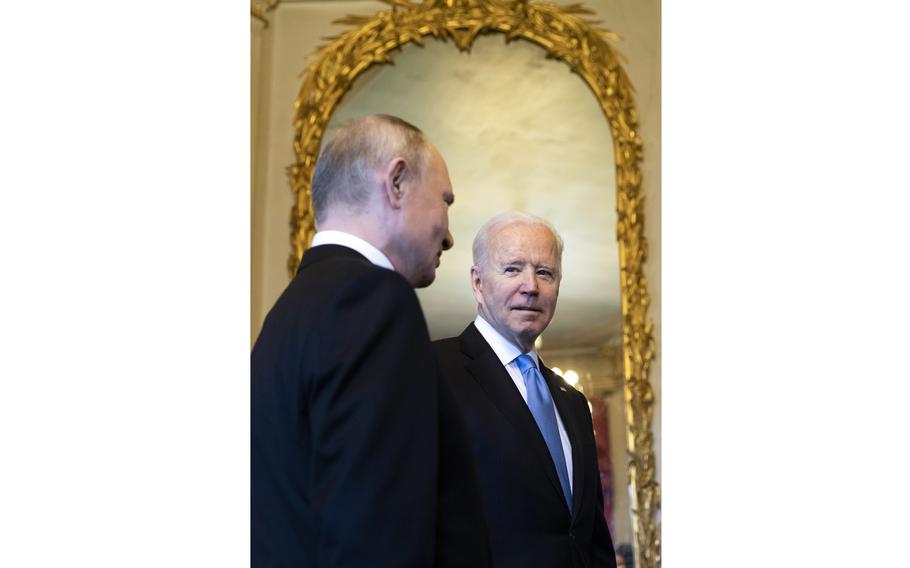
President Joe Biden, right, and Russian President Vladimir Putin meet during the U.S. Russia summit at Villa La Grange on June 16, 2021, in Geneva, Switzerland. (Peter Klaunzer, Pool, Keystone, Getty Images/TNS)
(Tribune News Service) — On Tuesday, Russian President Vladimir Putin announced that Moscow will suspend implementation of New START, the last remaining treaty between Russia and the United States limiting deployed nuclear weapons.
New START limits the number of “strategic” nuclear warheads that Russia and the United States can deploy to 1,550 and the number of deployed strategic nuclear-capable missiles and bombers to 700. The agreement, like its predecessors, was important in limiting arms race pressures, strengthening strategic stability and facilitating communication, transparency and predictability between the world’s two largest nuclear powers.
Putin’s decision, a “suspension” rather than a full withdrawal, is a partial measure. Russia is still party to the agreement. Moscow has claimed that it would continue to adhere to the numerical ceilings established in New START and that it would continue to comply with a 1988 agreement with the U.S. to exchange notifications of launches of intercontinental ballistic missiles and submarine-launched ballistic missiles.
The immediate effects of the suspension are likely limited. The U.S. can still monitor Russian compliance through what are called “national technical means,” which include satellite imagery. Russia’s ongoing nuclear modernization is already costly and behind schedule and the sanctions against Russia could further jeopardize those efforts. However, Russian suspension of the treaty will, for now, likely mean an end to treaty-mandated data exchanges, on-site inspections and meetings of the Bilateral Consultative Commission, a body established by the treaty to facilitate implementation and compliance.
The treaty was already under pressure. Earlier this year, the State Department, in a report to Congress, stated that Russia was not complying. Under the treaty, each side is permitted to conduct a limited number of on-site inspections of the other’s nuclear bases annually and may convene meetings of the Bilateral Consultative Commission to discuss compliance concerns. According to the State Department report, Moscow has denied American inspectors access to Russian nuclear facilities and failed to convene a session of the Bilateral Consultative Commission in a timely fashion.
Putin’s decision may give legal cover to Russia’s previous decisions to deny U.S. inspectors access and is a sop to domestic hardliners already skeptical of arms control agreements. But his decision may have had other motives as well. It likely also signals a willingness to impose costs on the U.S. for its support of Ukraine when Russia lacks other credible military or economic tools.
The decision could also entail costs for Russia. The U.S. could match Russian suspension and stop providing data or permitting inspections. Indeed, a U.S. official stated that “The principles of reciprocity, mutual predictability, and mutual stability will continue to guide the U.S. approach to implementation of the New START Treaty.” The suspension will further increase Russia’s diplomatic costs worldwide. Commenting on Putin’s announcement, a spokesperson for China’s Foreign Ministry, while refraining from criticizing Russia, still noted that Beijing “hopes the two sides can properly resolve the differences through constructive dialogue and consultation to ensure the treaty’s sound implementation.”
Russian suspension of New START is only the latest arms control casualty. In 2019, President Donald Trump, citing evidence of Russian noncompliance, suspended and ultimately withdrew from the Intermediate-Range Nuclear Forces Treaty with Russia, which prohibited deployments of ground-based missiles with ranges between 500 and 5,500 kilometers (about 310 to 3,400 miles). In 2020, the U.S. announced it would withdraw from the Open Skies Treaty, an agreement that facilitated transparency by permitting reciprocal unarmed aerial surveillance flights. The U.S. withdrawal, which was opposed by NATO allies (and also Ukraine), was premised on allegations of Russian violations — and was followed shortly afterward by Russian withdrawal.
So what does Putin’s latest move mean?
First, it demonstrates that Russia is increasingly unwilling to compartmentalize elements of its relations with the United States. In the past, Russia (and its Soviet predecessor) and the U.S. managed to negotiate, extend and implement nuclear arms agreements while clashing on other issues.
Second, it further undermines nuclear arms control efforts, placing a unique agreement — set to expire in 2026 — on life support. The treaty is the last of its kind; no other nuclear states have ever negotiated limits to their nuclear forces. Its poor health may signal to other nuclear-armed states that arms control may not be worthwhile.
It will be important for the United States not to react rashly or get drawn into an arms race. U.S. strategic nuclear forces are still strong and the balance is unlikely to change in the near-term. But nuclear arms control as an international project has certainly been further diminished.
David C. Logan is an assistant professor at the U.S. Naval War College. The views expressed here are those of the author alone.
©2023 Los Angeles Times.
Visit at latimes.com.
Distributed by Tribune Content Agency, LLC.